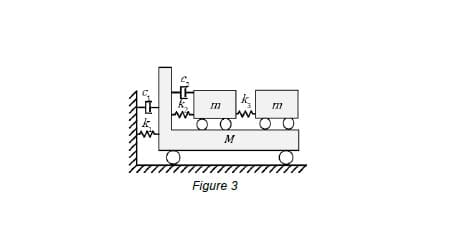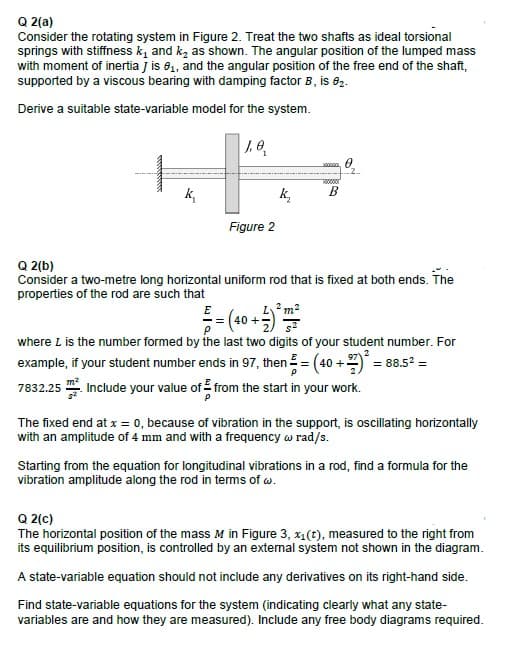Q 2(a) Consider the rotating system in Figure 2. Treat the two shafts as ideal torsional springs with stiffness k, and k, as shown. The angular position of the lumped mass with moment of inertia j is 8,, and the angular position of the free end of the shaft, supported by a viscous bearing with damping factor B, is 62. Derive a suitable state-variable model for the system. 1.e k, k, Figure 2 Q 2(b) Consider a two-metre long horizontal uniform rod that is fixed at both ends. The properties of the rod are such that E 40 + where L is the number formed by the last two digits of your student number. For example, if your student number ends in 97, then = (40 +) = 88.52 = 7832.25 Include your value of from the start in your work. The fixed end at x = 0, because of vibration in the support, is oscillating horizontally with an amplitude of 4 mm and with a frequency w rad/s. Starting from the equation for longitudinal vibrations in a rod, find a formula for the vibration amplitude along the rod in terms of w. Q 2(c) The horizontal position of the mass M in Figure 3, x1(t), measured to the right from its equilibrium position, is controlled by an extemal system not shown in the diagram. A state-variable equation should not include any derivatives on its right-hand side. Find state-variable equations for the system (indicating clearly what any state- variables are and how they are measured). Include any free body diagrams required.
Q 2(a) Consider the rotating system in Figure 2. Treat the two shafts as ideal torsional springs with stiffness k, and k, as shown. The angular position of the lumped mass with moment of inertia j is 8,, and the angular position of the free end of the shaft, supported by a viscous bearing with damping factor B, is 62. Derive a suitable state-variable model for the system. 1.e k, k, Figure 2 Q 2(b) Consider a two-metre long horizontal uniform rod that is fixed at both ends. The properties of the rod are such that E 40 + where L is the number formed by the last two digits of your student number. For example, if your student number ends in 97, then = (40 +) = 88.52 = 7832.25 Include your value of from the start in your work. The fixed end at x = 0, because of vibration in the support, is oscillating horizontally with an amplitude of 4 mm and with a frequency w rad/s. Starting from the equation for longitudinal vibrations in a rod, find a formula for the vibration amplitude along the rod in terms of w. Q 2(c) The horizontal position of the mass M in Figure 3, x1(t), measured to the right from its equilibrium position, is controlled by an extemal system not shown in the diagram. A state-variable equation should not include any derivatives on its right-hand side. Find state-variable equations for the system (indicating clearly what any state- variables are and how they are measured). Include any free body diagrams required.
Elements Of Electromagnetics
7th Edition
ISBN:9780190698614
Author:Sadiku, Matthew N. O.
Publisher:Sadiku, Matthew N. O.
ChapterMA: Math Assessment
Section: Chapter Questions
Problem 1.1MA
Related questions
Question
ans a
this is student ID is asked in question 17101298

Transcribed Image Text:M
Figure 3

Transcribed Image Text:Q 2(a)
Consider the rotating system in Figure 2. Treat the two shafts as ideal torsional
springs with stiffness k, and ką as shown. The angular position of the lumped mass
with moment of inertia j is 8, and the angular position of the free end of the shaft,
supported by a viscous bearing with damping factor B, is e2.
Derive a suitable state-variable model for the system.
k,
k,
B
Figure 2
Q 2(b)
Consider a two-metre long horizontal uniform rod that is fixed at both ends. The
properties of the rod are such that
E
2 m2
40 +
where L is the number formed by the last two digits of your student number. For
example, if your student number ends in 97, then = (40 +7) = 88.5? =
7832.25 . Include your value of from the start in your work.
The fixed end at x = 0, because of vibration in the support, is oscillating horizontally
with an amplitude of 4 mm and with a frequency w rad/s.
Starting from the equation for longitudinal vibrations in a rod, find a formula for the
vibration amplitude along the rod in terms of w.
Q 2(c)
The horizontal position of the mass M in Figure 3, x1(t), measured to the right from
its equilibrium position, is controlled by an external system not shown in the diagram.
A state-variable equation should not include any derivatives on its right-hand side.
Find state-variable equations for the system (indicating clearly what any state-
variables are and how they are measured). Include any free body diagrams required.
Expert Solution
This question has been solved!
Explore an expertly crafted, step-by-step solution for a thorough understanding of key concepts.
Step by step
Solved in 2 steps with 1 images

Knowledge Booster
Learn more about
Need a deep-dive on the concept behind this application? Look no further. Learn more about this topic, mechanical-engineering and related others by exploring similar questions and additional content below.Recommended textbooks for you

Elements Of Electromagnetics
Mechanical Engineering
ISBN:
9780190698614
Author:
Sadiku, Matthew N. O.
Publisher:
Oxford University Press

Mechanics of Materials (10th Edition)
Mechanical Engineering
ISBN:
9780134319650
Author:
Russell C. Hibbeler
Publisher:
PEARSON

Thermodynamics: An Engineering Approach
Mechanical Engineering
ISBN:
9781259822674
Author:
Yunus A. Cengel Dr., Michael A. Boles
Publisher:
McGraw-Hill Education

Elements Of Electromagnetics
Mechanical Engineering
ISBN:
9780190698614
Author:
Sadiku, Matthew N. O.
Publisher:
Oxford University Press

Mechanics of Materials (10th Edition)
Mechanical Engineering
ISBN:
9780134319650
Author:
Russell C. Hibbeler
Publisher:
PEARSON

Thermodynamics: An Engineering Approach
Mechanical Engineering
ISBN:
9781259822674
Author:
Yunus A. Cengel Dr., Michael A. Boles
Publisher:
McGraw-Hill Education

Control Systems Engineering
Mechanical Engineering
ISBN:
9781118170519
Author:
Norman S. Nise
Publisher:
WILEY

Mechanics of Materials (MindTap Course List)
Mechanical Engineering
ISBN:
9781337093347
Author:
Barry J. Goodno, James M. Gere
Publisher:
Cengage Learning

Engineering Mechanics: Statics
Mechanical Engineering
ISBN:
9781118807330
Author:
James L. Meriam, L. G. Kraige, J. N. Bolton
Publisher:
WILEY